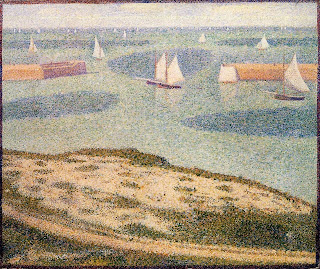For the Neo-Impressionists, it was Georges Seurat, who used his pointilist technique to paint large-scale scenes composed of complimentary-colored dots that would mix optically:
Port-en-Bessin. Georges Seurat.
Port-en-Bessin, Entrance to the Outer Harbor. Georges Seurat.
For Contemporary artists, it was Chuck Close.
Close puts a grid on the photo and on the canvas and copies cell by cell. Typically, each square within the grid is filled with roughly executed regions of color (usually consisting of painted rings on a contrasting background) which give the cell a perceived 'average' hue which makes sense from a distance.
Chuck Close painting.
Self-Portrait. Chuck Close.
Self-Portrait. Chuck Close.
Based on this theory, both scientists and artists alike are now working to create large-scale scenes and 3D renderings that are built from smaller building blocks – 2D photos.
Below is an image from the "Rome in a Day" project, by computer science researchers at the University of Washington and Cornell University, who have been using algorithms to match similar points on multiple photographs shot of the same scene/object from varying vantage points to build 3D renderings and models of that scene/object (read: NYTimes: Computers Turn Flat Photos into 3-D Buildings):
A 3-D reconstruction of the Colosseum in Rome, built as part of the “Rome in a Day” project, which used 2,106 images and 819,242 points.
Jeffrey Martin, a panoramic photographer, is the Founder of 360Cities.net, a project to create large-scale spherical panoramas that are geo-referenced. By stitching together hundreds of photographs taken with a high-powered 200mm lens, Martin created the largest spherical panoramic photograph in the world (18.4 gigapixels) from the Prague TV Tower.
Prague from the TV Tower - 18 Gigapixel Panoramic Photo. Jeffrey Martin.
From: http://www.360cities.net.











No comments:
Post a Comment